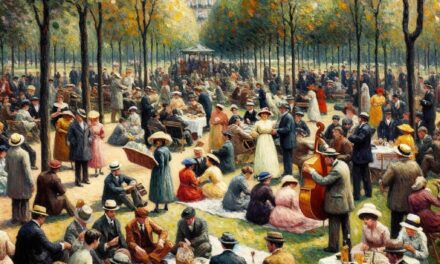Futurism emerged as an artistic and social movement in Italy during the early 20th century. The Italian poet Filippo Tommaso Marinetti founded the movement, publishing the “Futurist Manifesto” in 1909. This manifesto served as a radical call to action, rejecting the past whilst embracing the future, technology and modernity.
Marinetti and his fellow futurists aimed to break from traditional artistic and cultural norms, instead embracing the dynamism and energy of the modern world. The movement drew inspiration from the speed and power of the industrial age, as well as advancements in science and technology. Futurism extended beyond art, encompassing social and political aspects, with its adherents advocating for a comprehensive overhaul of society and culture.
The futurists were significantly influenced by the philosophies of Nietzsche and Bergson, which emphasised individualism, dynamism and the rejection of traditional values. They sought to create a novel aesthetic that reflected the speed, energy and violence of the modern world. Futurist art was characterised by bold use of colour, dynamic compositions and an emphasis on movement and speed.
The futurists also utilised new technologies such as photography, film and the printing press to disseminate their ideas to a broader audience. Futurism rapidly spread beyond Italy’s borders, exerting a considerable influence on the development of modern art and culture.
Summary
- Futurism originated in Italy in the early 20th century as a movement that celebrated modernity, technology, and the future.
- Key principles of Futurism include a rejection of traditional art and literature, an embrace of technology and industrialization, and a focus on speed, energy, and dynamism.
- Influential Futurist artists and writers include Filippo Tommaso Marinetti, Umberto Boccioni, and Giacomo Balla, who created dynamic and abstract works that reflected the movement’s principles.
- Futurism had a significant impact on society and culture, influencing fields such as art, literature, architecture, and design, and contributing to the development of modernist and avant-garde movements.
- Criticisms and controversies surrounding Futurism include its association with fascism, its glorification of war and violence, and its neglect of social and humanistic values.
- In the 21st century, Futurism continues to inspire artists, designers, and thinkers, and its principles are being embraced in fields such as technology, innovation, and urban planning.
- Embracing Futurism in daily life can involve adopting a forward-thinking mindset, embracing change and innovation, and seeking inspiration from modern art, design, and technology.
Key Principles of Futurism
The Rejection of the Past
One of the central tenets of futurism was its rejection of the past and tradition. The futurists believed that the past was outdated and irrelevant, and that it was necessary to break away from it in order to embrace the future. They sought to create a new aesthetic that reflected the speed, energy, and violence of the modern world. This rejection of tradition extended beyond art and culture to encompass all aspects of society, including politics, economics, and social norms.
The Celebration of Technology and Modernity
Another key principle of futurism was its celebration of technology and modernity. The futurists were fascinated by the advancements in science and technology that were transforming the world around them. They saw technology as a means of liberation and empowerment, and sought to harness its potential in their art and in society at large. This celebration of technology was reflected in their art, which often depicted machines, factories, and urban landscapes.
The Embracing of New Technologies
The futurists also embraced new technologies such as photography, film, and the printing press to disseminate their ideas to a wider audience.
Influential Futurist Artists and Writers

Futurism produced a number of influential artists and writers who played a significant role in shaping the movement and its impact on modern art and culture. One of the most prominent futurist artists was Umberto Boccioni, whose dynamic and energetic sculptures captured the spirit of the modern age. Boccioni’s work often depicted human figures in motion, reflecting the futurist fascination with speed and movement.
His most famous work, “Unique Forms of Continuity in Space,” is considered a masterpiece of futurist sculpture. Another influential figure in futurism was Giacomo Balla, whose paintings captured the energy and dynamism of modern life. Balla was known for his use of bright colours and bold geometric shapes, which conveyed a sense of movement and speed.
His work often depicted urban scenes, such as bustling streets and crowded cafes, reflecting the futurist fascination with the modern city. In addition to visual artists, futurism also produced a number of influential writers who played a key role in shaping the movement’s ideas and principles. Filippo Tommaso Marinetti, the founder of futurism, was not only a poet but also a prolific writer and public speaker who tirelessly promoted futurist ideas.
Marinetti’s “Futurist Manifesto” laid out the key principles of the movement and called for a complete overhaul of society and culture. His passionate advocacy for futurism helped to spread its influence beyond Italy and into other parts of Europe.
Futurism’s Impact on Society and Culture
Futurism had a significant impact on society and culture during the early 20th century, influencing not only art but also literature, music, architecture, and even politics. The futurists sought to break away from traditional artistic and cultural norms and embrace the dynamism and energy of the modern world. Their rejection of tradition extended beyond art and culture to encompass all aspects of society, including politics, economics, and social norms.
Futurism also had a profound impact on architecture, with its emphasis on modernity and technology influencing the design of buildings and urban spaces. The futurists sought to create a new aesthetic that reflected the speed, energy, and violence of the modern world. This rejection of tradition extended beyond art and culture to encompass all aspects of society, including politics, economics, and social norms.
In addition to its impact on art and architecture, futurism also had a significant influence on literature and music. Futurist writers sought to break away from traditional literary forms and embrace new modes of expression that reflected the speed and energy of modern life. They experimented with typography, layout, and language to create works that were dynamic and unconventional.
Similarly, futurist composers sought to break away from traditional musical forms and embrace new technologies such as electronic instruments to create music that reflected the dynamism of the modern age.
Criticisms and Controversies Surrounding Futurism
Despite its influence on modern art and culture, futurism was not without its controversies and criticisms. One of the main criticisms levelled against futurism was its glorification of violence and war. The futurists were fascinated by the power and energy of war, which they saw as a means of rejuvenating society and purging it of its decadence.
This celebration of violence led many to accuse futurism of being militaristic and aggressive. Another criticism of futurism was its association with fascism. Many futurists were sympathetic to fascist ideologies, seeing them as a means of realising their vision for a new society.
This association with fascism tarnished the reputation of futurism in the years following World War II, leading many to view it as a reactionary and dangerous movement. In addition to these criticisms, futurism was also accused of being elitist and out of touch with the realities of everyday life. The futurists’ celebration of technology and modernity was seen by some as being disconnected from the struggles of ordinary people, who were often left behind by the rapid pace of change.
Futurism in the 21st Century

The Futurist Philosophy
The futurists sought to break away from traditional artistic and cultural norms and embrace the dynamism and energy of the modern world. Their rejection of tradition extended beyond art and culture to encompass all aspects of society, including politics, economics, and social norms.
Futurism’s Enduring Influence
In recent years, there has been a renewed interest in futurism as a source of inspiration for contemporary artists, designers, and thinkers. The futurists’ celebration of technology and modernity continues to be relevant in an age defined by rapid technological advancements and social change. Many contemporary artists are drawing on futurist ideas to create works that reflect the speed, energy, and complexity of modern life.
Futurism Beyond Art
In addition to its influence on art, futurism also continues to inspire thinkers in fields such as science, technology, and philosophy. The futurists’ emphasis on innovation, progress, and individualism has found resonance in contemporary discussions about the future of humanity and society. Futurist ideas about embracing change, challenging tradition, and harnessing technology continue to be relevant in an age defined by rapid technological advancements and social change.
Embracing Futurism: How to Incorporate Futurist Ideas into Daily Life
While futurism may have originated as an artistic movement, its ideas can be applied to everyday life in a variety of ways. One way to incorporate futurist ideas into daily life is to embrace change and innovation. The futurists celebrated technology as a means of liberation and empowerment, seeing it as a tool for creating a better future.
In our own lives, we can embrace new technologies and innovations that have the potential to improve our quality of life. Another way to incorporate futurist ideas into daily life is to challenge tradition and embrace individualism. The futurists rejected traditional values and norms in favour of creating a new aesthetic that reflected the speed, energy, and violence of the modern world.
In our own lives, we can challenge outdated norms and expectations that may be holding us back from realising our full potential. Finally, we can incorporate futurist ideas into daily life by embracing creativity and experimentation. The futurists were known for their bold use of colour, dynamic compositions, and an emphasis on movement and speed in their art.
In our own lives, we can seek out opportunities for creative expression and experimentation that allow us to explore new ideas and ways of thinking. In conclusion, futurism was a radical artistic movement that sought to break away from tradition and embrace the dynamism and energy of the modern world. Its influence on modern art and culture continues to be felt today, with many contemporary artists drawing on futurist ideas for inspiration.
While futurism may have been associated with controversies and criticisms in its time, its principles continue to resonate in an age defined by rapid technological advancements and social change. By embracing change, challenging tradition, embracing individualism, creativity, experimentation we can incorporate futurist ideas into our daily lives in meaningful ways that reflect the spirit of this influential movement.
If you are interested in learning about different art movements, you may also want to check out an introduction to prehistoric art. This article explores the origins of art and the earliest forms of human expression through cave paintings and other prehistoric artefacts. It provides a fascinating insight into the evolution of art and its significance in human history. You can read the full article here.
FAQs
What is Futurism?
Futurism is an artistic and social movement that originated in Italy in the early 20th century. It emphasized the dynamism, speed, technology, and modernity of the industrial age.
Who were the key figures of Futurism?
The key figures of Futurism were Filippo Tommaso Marinetti, the founder of the movement, and artists such as Umberto Boccioni, Giacomo Balla, and Gino Severini.
What were the main themes of Futurist art?
Futurist art focused on themes such as movement, speed, technology, and the modern urban environment. It often depicted dynamic, fragmented, and abstract forms to convey a sense of energy and progress.
How did Futurism influence other art forms?
Futurism had a significant impact on other art forms, including literature, music, architecture, and design. It inspired new ways of thinking about the relationship between art and technology.
What was the legacy of Futurism?
The legacy of Futurism can be seen in the development of modern art movements such as Dada, Surrealism, and Constructivism. It also influenced the aesthetics of advertising, fashion, and industrial design.




